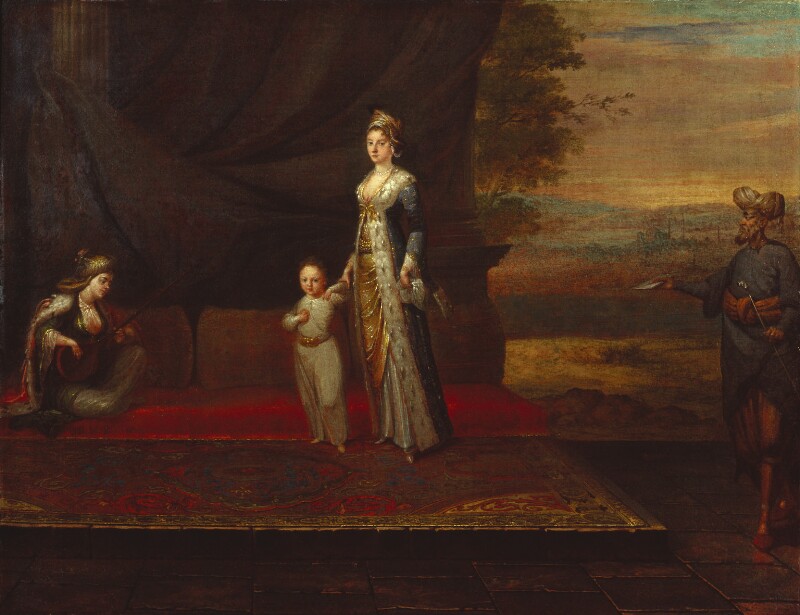Headnote for Lady Mary Wortley Montagu
By
John O'Brien
 Source: Portait of Lady Mary Wortley Montagu with her son Edward and two unnamed Turkish servants. Probably painted by Jean Baptiste Vanmour, a French painter who worked for much of his career in Constantinople, painting both local scenes and visiting Europeans (National Portrait Gallery, UK)
Source: Portait of Lady Mary Wortley Montagu with her son Edward and two unnamed Turkish servants. Probably painted by Jean Baptiste Vanmour, a French painter who worked for much of his career in Constantinople, painting both local scenes and visiting Europeans (National Portrait Gallery, UK)
Few English people saw more of the world in the eighteenth century than did Mary Wortley Montagu. And perhaps no one wrote a more enduringly interesting and engaging account of her travels. Lady Mary’s account of her trip from London to Constantinople (modern-day Istanbul) from 1716 to 1718 when her husband was named the English ambassodor to the Ottoman Empire is the best first-hand account in English of the Ottoman court, and offers fascinating and often sympathetic insight into the culture of what is now the nation of Turkey. And Lady Mary was also a prominent poet and essayist who contributed to public debates about medicine, marriage, and the place of women in society.
She was born into a prominent aristocratic family in 1689, and she was a precocious child. But her mother died when she was eight years old, and her father was negligent and self-absorbed. Young Mary largely educated herself in the family library, learning Latin and writing copious amounts of poetry and fiction. In her early twenties, she began a clandestine correspondence with Edward Wortley Montagu, also from a prominent family, after his sister and her best friend Anne died. They corresponded for about a year and half, which would have been an enormous scandal (such correspondence between unmarried young men and women was definitely not OK), and when her father found out about it, he was furious and tried to get her to stop the correspondence. He set up a marriage between her and an Irish heir with the truly wonderful name of Clotworthy Skeffington. She was completely uninterested in Skeffington, and the crisis created by her father's demands prompted Mary and Edward to elope, which they did in August 1712.
They moved to London. There, Lady Mary was a popular socialite, admired for her beauty, wit, and intelligence. She collaborated on poems with Alexander Pope and John Gay, poems that circulated in manuscript among their circle of friends—-or at least they did until an unscrupulous publisher got hold of a copy and printed some, which infuriated them all. Lady Mary published an essay in the Spectator, a satirical essay on marriage that probably tells us something about some discontent with Edward, who was often away from home on political and business ventures. She was the only woman to contribute to Addison and Steele’s periodical. She almost died in 1716 when she contracted smallpox, a disease that had already killed her brother. She survived, but the experience was recorded in a poem, “The Small-Pox,” published after her death. It also seems to have motivated her to learn about ways to prevent others from being similarly afflicted. An opportunity would come soon.
Edward Montagu was appointed as the English Ambassador to the Ottoman Empire in May 1716. He, Lady Mary, and their very young son Edward set out for the long journey across Europe to Constantinople. It is hard now for us to imagine how difficult such a journey would have been in an era without paved roads or predictable traveller’s lodgings. The traveling party of the Montagus, various servants, and diplomatic staff travelled by coach and horseback over mountains and in snow, sometimes sleeping in hovels. They arrived in Constantinople in March 1717, and Lady Mary spent her time well, visiting Turkish families and learning about the culture. She learned about the Turkish practice of inoculation, by which people were given a very small amount of the smallpox virus, which protected them against a full-scale infection. Throughout her travels across Europe and her time in the Ottoman Empire, Lady Mary kept an active corresponded with people back in England. Later, she mined those letters for a “letter book,” reworking the original texts into a more shapely narrative. The letter book, now most often referred to as the Turkish Embassy Letters, circulated in manuscript among her friends for decades, and was published after her death. After her return to England Lady Mary became a public advocate for inoculation, had her own children inoculated and convinced the Queen to inoculate her children as well.
Montagu’s family relationships were always complicated ones, and both her marriage and her relationship with her two children were often filled with conflict. Her son Edward struggled at school and seems to have fought with his parents; his father eventually disowned him. Her daughter Mary fell in love with a Scottish aristocrat, John Stuart, the Earl of Bute, who had a title but no money; she eventually followed her parents’ example and married without their approval. (Bute would eventually become Prime Minister, but that kind of success was not obvious at the time of the marriage.) Lady Mary herself fell in love with an Italian aristocrat, Francesco Algarotti, and moved to Venice to be with him in 1736, and never saw her husband again. The relationship with Algoratti came to an end in 1741, but she stayed on the Continent until after her husband’s death in 1761. She died in London in 1762.